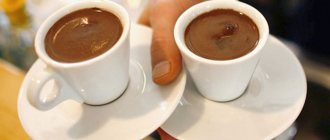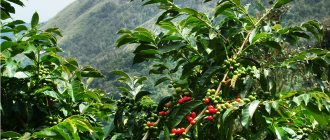The birthplace of coffee is ancient Ethiopia.
Ethiopia is one of the main coffee producers in the world and on the African continent.
Coffee trees are far from uncommon in different countries, but they appeared there not so long ago. The plants that produce the bitter, aromatic Arabica beans originate in ancient Ethiopia. It was here that the trees from which all the varieties originated were first discovered.
It will come as a surprise to Robusta lovers that their favorite drink comes from Africa. The Congolese coffee tree is native to the grassy banks of the Congo River.
Interestingly, the coffee drink was first prepared not in Africa, but in ancient Arabia. Africans simply used bitter grains as a spice in cooking.
Most are grown in Brazil (about 3 million tons per year), Vietnam (about 1.8 million tons), Colombia (800 thousand tons). Where coffee beans are planted in special nurseries, providing sufficient lighting and climatic conditions. After six months, seedlings are sent to pre-fertilized fields. The first fruiting begins after two years. Coffee beans are collected by hand, with the participation of seasonal workers.
Coffee interesting facts for health from the point of view of medicine and science
- Coffee has a beneficial effect on life expectancy. A study published in the European Journal of Epidemiology shows that coffee drinkers reduce the risk of diseases such as Parkinson's disease, type II diabetes, heart disease, prostate and liver cancer.
- Coffee helps fight depression, especially for women. Caffeine stimulates the central nervous system and acts as an antidepressant by increasing serotonin and dopamine levels. Source
- An analysis of data from 80,173 people in 2020 found that drinking one to four cups of coffee a day reduced the risk of suicidal ideation in women. However, it had no effect on suicidal ideation in men.
- Research published on ScienceDaily shows that coffee reduces muscle pain, improves energy production and promotes a positive feeling of exercise. Caffeine reduces muscle pain by up to 50% if you drink about 2 cups before exercise.
- According to recent research, drinking coffee regularly can help you lose weight. If, of course, you drink it in small quantities and with a small amount of skim milk.
- According to researchers in South Korea, as reported by BBC News, "Drinking a strong cup of coffee may relieve symptoms of hay fever and prevent serious allergic reactions to nuts, bee stings and even anaphylactic shock."
- Recent studies have found that coffee drinks may reduce the risk of liver cancer, cancer of the uterine lining, fibrosis and cirrhosis.
- Drinking coffee is good for improving memory. Researchers from Johns Hopkins University found that the caffeine contained in the drink has a positive effect on our long-term memory.
- A 2009 study found that people who drink three to five cups of coffee a day reduce their risk of developing dementia or Alzheimer's disease as they age.
- Coffee grounds are a physical exfoliant that can remove dead skin cells, leaving your skin feeling smooth and bright. That's why girls love to rub themselves with coffee grounds in the bathhouse.
Short interesting facts about coffee
- Coffee gets its name from the old Arabic word “gahwah” or Turkish “kahweh”, which means “relieving fatigue” or “lifting force”.
- Coffee is the second largest commodity in the world in terms of sales after oil and is valued at $100 billion.
- The name "cappuccino" comes from the Capuchin religious order. The color of the espresso coffee mixed with frothed milk was similar to the color of the capuchin robe.
- Chilled coffee helps remove salt marks from brown leather shoes.
- New Yorkers are true coffee lovers. New Yorkers drink nearly seven times more coffee than residents of other US cities.
- This is the most popular breakfast drink. Of all the drinks served during breakfast, coffee makes up 65%.
- Green coffee beans can be stored for up to 10 years.
- Hawaii and Puerto Rico are the only places in the United States where coffee is grown.
- What exactly does caffeine look like? The colorful object in the picture is caffeine under an electron microscope.
- Coffee with cream cools about 20% slower than regular black coffee, so it stays warm longer.
- Adding milk weakens the effect of caffeine.
- The human body absorbs caffeine much more slowly when milk is added to coffee.
- Coffee contains more than 1,200 chemicals, half of which are responsible for creating its aroma.
- The Japanese believe that bathing in coffee grounds mixed with pineapple pulp will reduce wrinkles and brighten the skin.
- The coffee industry employs 25 million people worldwide.
- Melitta Benz, a housewife from Dresden, Germany, invented the first coffee filter in 1908.
- In Colombia and Brazil, the entire economy is based on the sale of coffee.
- The lethal dose of coffee for most people is about 10 grams. Depending on the person's weight and the type of coffee drink, this is approximately 50 to 100 cups.
- Where did Irish coffee come from? In 1942, it began to be served with Irish whiskey to warm cold and tired passengers during or after a flight.
- For the average person, the best time to drink coffee is said to be between 9:30 and 11:30, which helps maximize alertness.
10 unknown and unusual facts about coffee
- The average American spends $1,092 a year on coffee. That's about $20 a week. It's also priced close to the latest iPhone.
- “Dying Wish” is the name of the strongest coffee in the world. It has double the strength of a regular cup of coffee without being bitter or sour.
- Starbucks is one of the leading coffee chains in the world. You can only measure their progress through statistics. The company has been opening 2 stores every day since 1987, without stopping.
- The largest coffee mug was made in South Korea. This mug had a capacity of over 14,000 liters. And the largest iced coffee cup (5600 liters) was produced in Las Vegas in 2010.
- The first coffee machine was invented, patented and manufactured in Italy by Italian inventor Luigi Bezzera. He officially presented his invention at the International Fair in Milan in 1906.
- October 1 is celebrated annually as International Coffee Day. Until 2015, the holiday was celebrated in different countries on different days. The purpose of the holiday is to celebrate one of the most popular drinks and raise awareness about sustainable coffee farming, as well as fair trade practices in the coffee industry.
- Global coffee consumption is approximately 450 billion cups per year or 2.25 billion cups daily. Of which, 400 million are drunk daily in the US alone.
- How much coffee can you harvest from one coffee tree? Coffee trees can produce approximately 0.5-3.6 kg per year, averaging 0.7-0.9 kg over 15-20 years. It takes 3 to 4 years for a coffee tree to mature.
- The four most popular types of coffee are Arabica (about 60%), Robusta (over 30%), Excelsa (about 7%) and Liberica (about 2%) of world production. Together they make up 99% of the coffee market.
- Coffee and alcohol are a dangerous combination. Caffeine neutralizes the effects of alcohol, causing you to lose the sense of how much alcohol you drink. As a result, a person drinks more than usual, which can lead to alcohol poisoning.
Interesting facts about coffee beans
- Brazil is currently considered the world leader in the supply of coffee beans. Its annual production volume is about 2.8 million tons.
- The first Europeans to trade coffee beans were the Dutch. They imported it from the Malabar coast to India.
- Coffee beans are not beans at all, but berries from a coffee tree bush.
- Some people say that roasting coffee beans will increase the amount of caffeine. However, in this case the opposite is also true. The more we roast the beans, the more caffeine is burned. Therefore, if you want to reduce your caffeine intake, you must roast your coffee beans well.
- To produce 1 kg of ground coffee, 5000 coffee beans are required.
- Coffee bags are usually made from hemp. It takes more than 600,000 coffee beans to fill them.
5 facts about coffee
- One cup of black coffee contains only one calorie. But adding sweeteners, cream and other additives can quickly raise the calorie count. For example, Starbucks' Venti Java Chip Frappuccino (coffee, chocolate and chocolate chips mixed with ice) contains 88 grams of sugar and 600 calories—more than a McDonald's Big Mac.
- Coffee was first known as "Qahhwat al-bun", which means "wine made from beans". Later the word was shortened to "Kahva", after which it was renamed by the Turks to "Kahve". In 1582, "coffee" entered the English language, derived from the Dutch word "Koffie".
- Starbucks is popular and successful because it knows how to take care of the business and its employees. The company spends more money on health insurance for its employees than they spend on coffee beans. This is another noticeable fact.
- Coffee calories in kilocalories: Espresso is about 5 kcal. Black coffee - 7 kcal. Coffee with milk - about 20 kcal. Americano with skim milk - about 10 kcal. Cappuccino sprinkled with chocolate chips - 140 kcal. Cold coffee made from instant coffee with milk and ice cubes - about 200 kcal. Strong coffee from a coffee machine with the addition of chocolate and cream is almost 400 kcal.
- 20 countries that drink the most coffee.
Facts about instant coffee
- Instant coffee first appeared in Britain, referred to as "coffee blend". But historians believe that the predecessor to modern instant coffee was independently created by three people in three different countries between 1880 and 1901. These are Frenchman Alphonse Halle, New Zealander David Strang and American Satori Kato. And in 1909, Belgian George Washington began mass production of instant coffee.
- The coffee aroma you smell when you open a can of instant coffee is unfortunately artificial. It is added before the jar is closed and has nothing to do with the actual contents.
Coffee interesting facts, legends and stories
- During the American Civil War, soldiers who wanted coffee but couldn't get it tried roasting sweet potatoes and corn to make a similar drink.
- Initially, coffee was considered a miracle cure in Yemen and Arabia and was consumed only on the advice of a doctor. Many viewed it as a cerebral tonic or as a way to stimulate religious visions.
- When the ruler of Mecca, Cairo Bey, banned coffee in 1511, the Sultan sentenced him to death. The execution took place in a place where coffee was considered a “blessed drink.”
- The next attempt to ban coffee came in the 16th century by Italian monks. They appealed to Pope Clement VIII to ban the Saracen drink. However, the pope said that the drink was so good that it would be a sin to allow only pagans to drink it.
- Legend has it that a 9th-century Ethiopian herder noticed the effects of caffeine on his goats, which seemed to "dance" after eating the fruits of the Coffea plant. Then a local monk made a drink with the fruit of the coffee tree and found that it kept him up at night. This is how the most popular drink appeared.
- Although coffee was discovered around 850, it only became a popular drink in 1100. This was facilitated by the port city of Mocha (Yemen). From there, coffee beans were exported by sea to India and Java, and from 1515 to Europe. After 160 years, there were more than 3,000 coffee shops in England alone.
- During the reign of Sultan Murad IV, drinking coffee was a major crime. Anyone caught drinking coffee received a death sentence.
- Before people learned how to brew coffee, East African tribes mixed coffee berries with animal fat and then consumed it as food.
- How did the name Americano come about? Americano, espresso with hot water, was invented by American soldiers during World War II. They thought European espresso was too strong, so they diluted it with hot water.
- The first coffee advertisement dates back to 1651 and was in the form of a leaflet. It is now in the British Museum.
Interesting facts about coffee shops
- In 1674, a group of London women formed a group called WPAC (Women Petition Against Coffee). They didn't like the amount of time their husbands spent in coffee shops instead of at home.
- The world's first coffee shop dates back to 1475 and was opened in Constantinople (modern Istanbul).
- Did you know that the French Revolution was planned in coffee shops? It was here that the intelligentsia, a class of political thinkers and polemicists, gathered to prepare their uprisings.
- The first coffee shop in England was opened in 1652 and was intended only for men. Women could only enter it to be served.
- There are several coffee shops in France where if you say “Hello” and “Please” you will get coffee at a lower price.
- The custom of tipping waiters originated in early European coffee shops to ensure good service in this loud, dirty, hectic place.
- The tradition of drinking coffee in Russia dates back to the time of Peter the Great. And the first coffee shop, “Four Frigates,” opened in St. Petersburg in 1720. But due to its high price, coffee remained a premium drink until the 20th century.
The first coffee shop in history opened in 1500
The first information about the coffee drink dates back to the 1000s AD.
The discoverers of invigorating nectar were the Arabs; it was they who brought grains from Africa and began to grow them on the Arabian Peninsula. The drink bore little resemblance to everyone’s usual coffee – cinnamon and crushed ginger coffee were added to the aromatic liquid. From the Arabian Peninsula, the coffee tree came to the Ottoman Empire. It was not until the 16th century that traders began transporting grains by sea to Europe.
It is said that the first coffee shop was opened in 1554 in the Tahtakale region by Halepli Hakem and Surieli Shems
The first coffee shop was opened in Turkey around 1500. Coffee appeared in England much later - around 1600. For a long time, only men were allowed to drink the invigorating liquid.
Bitter beans arrived in France in the 1700s; in Russia, the appearance of coffee occurred under Tsar Peter the Great. According to historians, the drink did not gain much popularity in the country. Tsar Peter had to open special coffee shops and almost force people to drink “bitter drink,” which is what his subjects called the aromatic liquid.
Unusual traditions
Information about coffee will be incomplete if we do not remember the coffee traditions that exist in different parts of the world in connection with the use of this famous drink.
Greek girls of marriageable age use the product to show their affection for the guy: by giving him a drink with a head of thick foam, the young lady lets him know that she likes him.
In Ecuador, where the coffee tree was discovered, they drink coffee in a somewhat strange way: they brew it very concentrated, add a lot of sugar (until thick) and put it in the refrigerator, from where they take it out as needed and pour boiling water over it.
In Syrian Damascus, tourists can try a local drink called “devilish”. It is served on a small plate and looks like a blob that needs to be licked off. The sensations will be unforgettable: a sharp taste will appear in the mouth, the person will feel an extraordinary surge of strength.
Although the Japanese are considered lovers and connoisseurs of tea, they are also fans of coffee, and even dedicated the first day of October to it.
Thais brew it with grains of rice, sesame or wheat, adding a lot of milk.
In Yemen, after the birth of an heir, everyone is treated to cardamom coffee. It is not customary to put sugar in it, so the drink is topped with dates.
In Finland, a piece of cheese is placed at the bottom of a coffee cup, which melts under the influence of the hot drink.
The name of coffee was given by the Arabs
The origin of the ancient name “coffee” entered the English language in 1598 from the Dutch word “koffie”.
Historians do not have a single opinion on where the name coffee came from. There are several versions, the most popular and quite plausible is associated with the nomadic Arabs. “Kava” translated from Arabic means “invigorating”, “giving strength”. It was this drink that nomads used to invigorate themselves during long marches. The name was preserved, but in Western European countries the drink began to be called “cafe” or “cafe”.
Another version is associated with the province of Kafa. It was here that trees were first grown for industrial purposes and named after their country. The name has been preserved, but has been slightly transformed.
Interesting facts from history
Goats are considered the pioneers of coffee. Ethiopian shepherds noticed that when animals ate coffee trees, they were more animated. After this, the Ethiopians began to mix animal fat with grains and roll the mixture into balls. They were eaten mainly by nomads during their travels.
Coffee as a drink became popular thanks to Islam. It was originally used by Arab Sufi monks. In the 15th century it became available to ordinary people in the East. The grain was first grown commercially in Yemen. Thanks to close trade with other Arab countries, in the 16th century the drink appeared in Syria, Turkey, Egypt, and Persia. Since drinking alcohol was prohibited by religion, coffee became an excellent substitute. Coffee shops called “wisdom schools” appeared.
After some time, the authorities decided to close the establishments, as they believed that during gatherings people would unite against them. Over time, the ban was lifted. Coffee became an important export product for the Arab states, and everything possible was done to prevent other countries from starting to grow it. The grains were lightly fried or boiled in boiling water so that they could not germinate.
In the 17th century, a pilgrim from India was able to secretly smuggle several grains from Mecca. This was the first recorded case of smuggling. Over time, the first plantation appeared in India, after which other countries in Southeast Asia began growing it. At the same time, the Dutch colonies became the main suppliers of coffee to European countries. The attitude towards the drink in Europe was ambiguous. In Venice, a conflict even arose over this issue, in which Pope Clement VIII intervened. His choice was in favor of an invigorating drink. The first coffee shops began to appear in Germany, Holland, France and England.
The Dutch also brought coffee to the territory of present-day New York. Americans still preferred tea, but after the tax on it was increased, they gradually switched to another drink. The Dutch brought this product to South America. The first plantations were in Suriname and Guyana. Portugal decided to start growing coffee in Brazil, but they couldn't get the beans. One day, the wife of the governor of Guyana gave the Portuguese lieutenant colonel a bouquet of flowers. Coffee beans were hidden in it. This is how the first plantations appeared in Brazil.
World coffee production reached 90,000 tons by 1820. Half of this was produced by Brazil. Today, the world drinks more than 500 billion cups of the invigorating drink, almost half of them at breakfast. In terms of sales volume in world trade, this product ranks 2nd after oil. Interesting facts about coffee are connected not only with the history of the drink.
There are four main types of coffee, not two.
Arabica, Robusta, Liberica and Excelsa: four types of coffee that grow on the globe
There are four varieties of coffee trees in the world. The most common is Arabica (Arabic coffee). It occupies about 70% of the world market and is considered a leader. It has a rich coarse aroma, a pleasant strong taste with bitterness. Often used to prepare coffee blends or instant granules.
Robusta is another variety of coffee trees, significantly inferior in production to Arabica. It has a sour aroma, refined taste, and slight sweetness. Used in pure form or in mixtures with Arabica.
The most popular Arabica coffee has a rich, bright aroma and a pleasant, strong taste with a hint of bitterness.
Two more types of varieties, less known, are Excelsa and Liberica. They have much in common with Robusta, but are significantly inferior in taste. They are used to give the drink strength and lasting aroma.
Coffee: history, types, production features
Good day, my dear readers. In one of the Friday selections of cocktails with coffee, I promised to tell you, in fact, about coffee. Then it somehow didn’t work out, and I was carried away into a slightly different topic. Actually, I must approach this drink with all responsibility, because coffee is a mystery of taste that deserves special respect. For those who have been drinking creepy black liquid from a can with “Nescafe” scratched all their life, the articles in the section on coffee that I just opened are a must read.
So, what does the almighty Wikipedia tell us about coffee? And she says that coffee is a drink that is prepared from roasted coffee beans , more precisely, from the beans of the coffee tree. Perhaps we can agree with her











